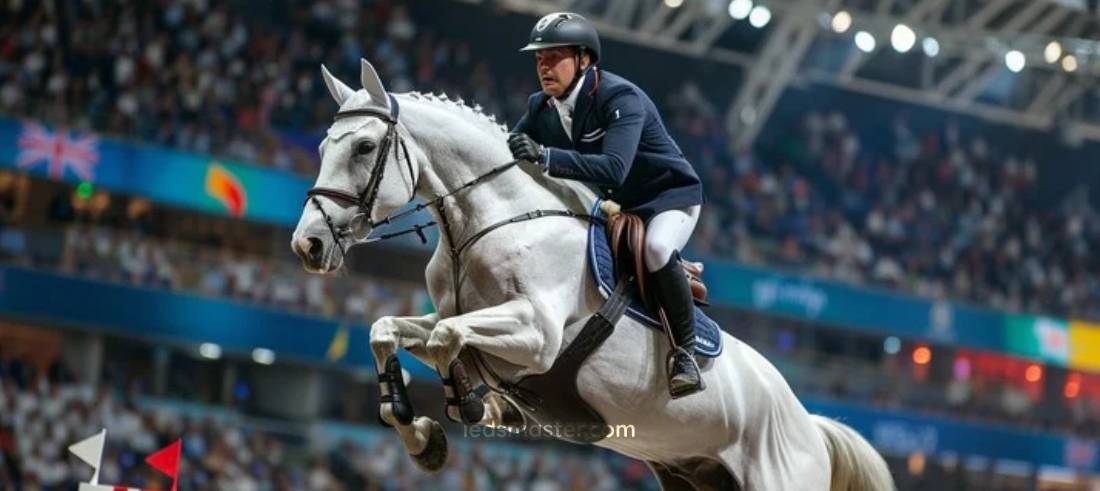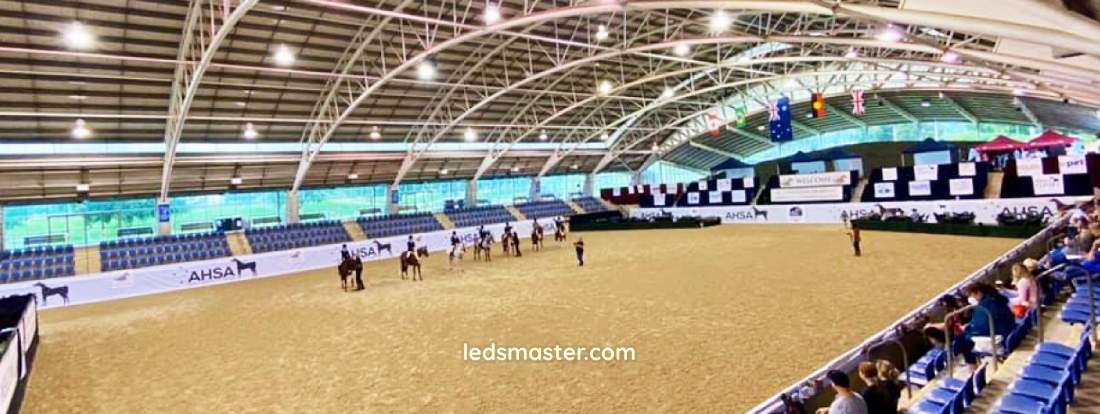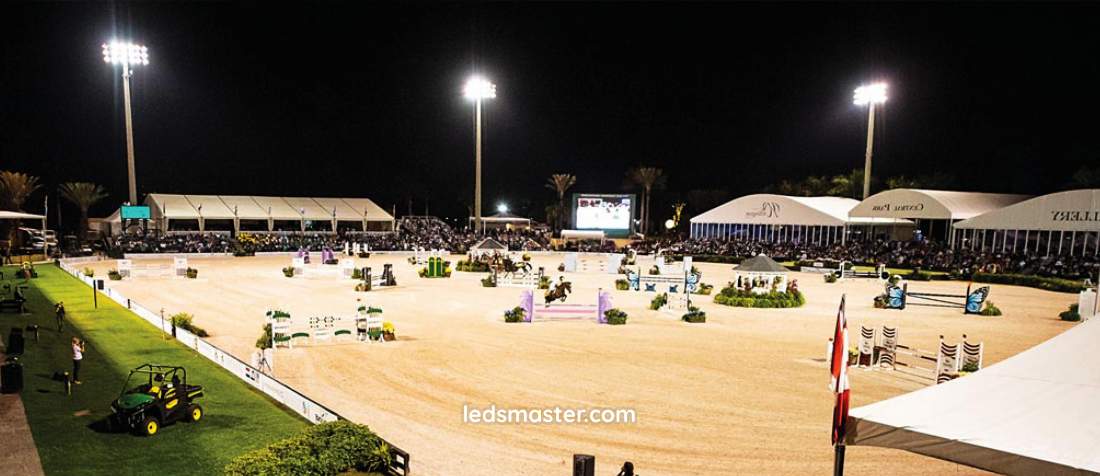Illuminate your arena with state-of-the-art LED technology designed for optimal visibility and performance. Our lighting systems ensure even, shadow-free illumination, enhancing safety and comfort for both riders and horses. Whether for training, competitions, or recreational riding, experience unmatched quality and efficiency with our cutting-edge lighting products.
Whether you are hosting competitions, training sessions, or casual riding, the right lighting can transform your arena into a safe, functional, and enjoyable environment for both horses and riders.
In this guide, we will explore the latest technologies in arena lighting, discuss the key factors to consider when choosing the right lighting solutions, and provide expert tips on installation and maintenance. From LED lights that mimic natural daylight to energy-efficient systems that save on costs, discover how you can enhance visibility, improve safety, and create a professional atmosphere in your horse arena.
Join us as we illuminate the path to better riding experiences and optimal performance with top-notch arena lighting solutions.
Get your complimentary lighting design today
Quality lighting enhances visibility, ensures safety, and creates a conducive environment for both horses and riders. This article provides a thorough understanding of horse arena lighting, covering the basics, benefits, and key considerations to help you choose the best lighting solutions for your arena.
Table of Contents
ToggleSafety is the foremost reason for ensuring proper lighting in a horse arena. Adequate lighting significantly reduces the risk of accidents by improving overall visibility. When the arena is well-lit, riders can clearly see obstacles, barriers, and potential hazards, allowing them to navigate the space more confidently and effectively. For horses, which can be easily startled by shadows or sudden changes in lighting, consistent and even illumination is crucial. It helps them move comfortably and predictably within the arena, reducing the likelihood of spooking or unexpected reactions that could lead to accidents.
In addition to enhancing safety, proper lighting can significantly improve the performance of both horse and rider. Good visibility allows riders to see and respond to the arena’s layout and any obstacles with greater precision and control. This level of clarity is particularly important during training sessions and competitions, where accuracy and timing are critical. A well-lit arena enables riders to practice and execute their routines more effectively, leading to better outcomes and higher performance standards.
Another benefit of effective arena lighting is the extended usability of the facility. With the right lighting solutions, arenas can be used during evening hours or in low-light conditions, such as during the early morning or on overcast days. This extended usability maximizes the utility of the space, allowing for more flexible scheduling of events, training sessions, and recreational riding. Riders and trainers are no longer limited by daylight hours, which can be particularly advantageous during shorter winter days or in regions with less consistent sunlight.
Moreover, well-lit arenas create a professional and inviting atmosphere. For competitive events, good lighting enhances the experience for both participants and spectators, making the arena look more polished and ensuring that every detail of the performance is visible. For regular training and casual riding, a well-lit arena feels safer and more welcoming, encouraging more frequent use. This professional ambiance can also contribute to the reputation of the facility, attracting more riders and events.

Several types of lighting can be used in horse arenas, each with its own advantages and considerations.
LED lighting is the most popular choice due to its energy efficiency, long lifespan, and bright, even illumination. LEDs produce minimal heat, which is safer for the horses and helps maintain a comfortable environment in the arena. The initial cost of LED fixtures can be higher, but the long-term savings in energy costs and reduced maintenance make them a cost-effective choice. LEDs also offer the advantage of instant-on capabilities, meaning they reach full brightness immediately without a warm-up period.
Metal halide lighting offers high-intensity illumination and good color rendering, which is important for competitive events where accurate color representation is necessary. However, metal halide lights are less energy-efficient compared to LEDs and take longer to warm up and cool down. They also produce more heat, which can be a consideration in enclosed arenas or warmer climates.
Halogen lighting is bright and has a lower initial cost, making it an attractive option for those with budget constraints. However, halogen lights are less energy-efficient and have a shorter lifespan than LEDs. They also generate a significant amount of heat, which can be uncomfortable for both horses and riders and may require additional cooling measures in the arena.
Fluorescent lighting is known for its energy efficiency and good coverage. These lights are often used in indoor arenas where lower ceilings allow for effective distribution of light. Fluorescents are not as bright or durable as LEDs and can be affected by temperature fluctuations, which might make them less suitable for outdoor arenas in regions with extreme weather conditions.

After the completion of your beautifully constructed horse arena, you may find yourself seeking the best methods to illuminate both indoor barns and outdoor arenas. Proper lighting is essential for functionality, safety, and enhancing the overall experience. This comprehensive guide will provide you with detailed insights into designing an effective lighting system for your equestrian facilities.
The brightness or lux level of your horse barn or arena plays a critical role in ensuring clear visibility and safety for both riders and horses. For recreational or training purposes, a general guideline suggests an illumination level of approximately 250 lux. This level of brightness is adequate for clear visibility and effective use of the space.
To calculate the total lumens required, you need to consider the area of your arena. For every 100 square meters, the recommended lighting level of 250 lux translates to a need for approximately 25,000 lumens. This is roughly equivalent to the output of 180-watt LED lights. By using this calculation, you can estimate the number of lights needed to achieve the desired brightness for your specific space.
In cases where you have high-mast poles, which are commonly used for larger arenas, it is important to select lighting fixtures with higher power and lumen output. High-mast lighting fixtures are designed to illuminate extensive areas from elevated positions, and thus require more powerful lighting to ensure even and adequate coverage. This initial calculation helps establish a foundational understanding of how to properly light your equestrian arena, ensuring that all areas are sufficiently illuminated.
When it comes to indoor barns, the weight-bearing capacity of the ceiling and the height of the installation are critical factors to consider. Ceilings in indoor barns are typically designed to support a certain weight, and exceeding this limit can pose safety risks. Therefore, choosing lighting fixtures that are lightweight yet effective is essential.
LED flood lamps are an excellent choice for indoor installations due to their relatively low weight compared to traditional lighting fixtures. This characteristic makes them safe and suitable for mounting on ceilings without compromising structural integrity. By selecting LED flood lamps, you can ensure that your indoor barn is well-lit while adhering to safety and design constraints.
For outdoor horse barns and arenas, energy efficiency and sustainability are important considerations. Solar-powered lighting offers a viable solution for reducing energy consumption while maintaining effective illumination. By integrating high-efficiency solar panels with your outdoor arena lights, you can harness solar energy to charge batteries during daylight hours.
These batteries typically provide between 3 to 5 hours of illumination, depending on the capacity of the batteries and the size of the solar panels. As the use of solar panels becomes increasingly popular among horse owners, it’s important to note that LED lights are particularly well-suited for this application. LEDs are known for their high energy efficiency, making them an ideal match for solar power systems. This is in contrast to traditional lighting options, such as metal halide, halogen, or mercury lamps, which consume significantly more energy and are less compatible with solar technology.
The initial investment in lighting fixtures and their ongoing maintenance can be substantial. Therefore, choosing durable and long-lasting lights is crucial for managing costs effectively. LED lights are a cost-effective choice due to their extended lifespan, which can reach up to 100,000 hours. This duration equates to approximately 34 years if the lights are used for 8 hours a day. Moreover, LED lights generally come with warranties ranging from 5 to 10 years, offering a guarantee of quality and dependable customer support.
Heat management is a vital aspect influencing the lifespan and performance of floodlights. Excessive heat can degrade the brightness and overall longevity of lighting fixtures. To address this issue, our LED lights are equipped with an advanced heat sink system featuring dense aluminum fins. This design enhances heat dissipation and helps maintain optimal performance over time.
Effective heat dissipation is crucial for maintaining the performance and longevity of lighting fixtures. Unlike some non-agricultural lights that may be prone to overheating, our LED lights are designed with robust heat management features to prevent problems such as reduced brightness or premature failure. Traditional incandescent lamps, for instance, tend to accumulate dust and cobwebs due to their heat output, which can increase the risk of fire and reduce overall efficiency.

Selecting the appropriate lighting for your horse arena involves careful consideration of several critical factors to achieve optimal results. Effective arena lighting ensures not only the safety and comfort of horses and riders but also enhances the overall functionality of the space.
The quality of light is paramount when choosing lighting for your horse arena. It is essential that the lights provide even, glare-free illumination to avoid shadows and dark spots, which can be disorienting or startling for horses. Uneven lighting can create areas of high contrast, making it difficult for riders and horses to navigate the arena safely. High-quality lighting ensures a consistent and uniform environment where horses and riders can perform with confidence and precision. This reduces the risk of accidents and improves overall visibility.
Arena lighting must be designed to withstand the demanding conditions of an outdoor environment. The fixtures should be robust and capable of enduring exposure to weather elements such as rain, wind, and extreme temperatures, as well as dust and debris commonly found in arena settings. Look for lighting fixtures constructed from durable materials with corrosion-resistant properties. Additionally, check for high weatherproof ratings, which indicate that the fixtures are designed to handle environmental stresses and physical impacts typical of an arena environment.
Choosing energy-efficient lighting solutions, such as LEDs, can have a significant impact on the operational costs of your arena. LEDs are known for their high energy efficiency, which means they consume less power compared to traditional lighting options. This reduction in energy consumption translates into lower utility bills and contributes to the overall sustainability of the facility. Furthermore, energy-efficient lighting typically requires less frequent maintenance and replacement, reducing the long-term costs associated with keeping the lighting system in good working order.
The strategic placement of light fixtures is crucial for achieving optimal illumination. The height and angle at which lights are mounted play a significant role in minimizing shadows and glare. Fixtures should be positioned to ensure even lighting across the arena, avoiding areas of excessive brightness or darkness that could disrupt the visual field of both horses and riders. Proper placement helps create a well-lit environment where movements can be clearly seen and assessed, enhancing safety and performance.
Selecting lighting solutions that require minimal maintenance is essential for reducing downtime and associated costs. Look for fixtures that have a long lifespan and are designed for easy maintenance. Features such as accessible bulb replacement and straightforward cleaning processes can significantly simplify the upkeep of the lighting system. Ensuring that the lighting is easy to maintain helps keep the system functioning at its best and reduces the frequency of repairs or replacements.
For the best results, it is advisable to hire a lighting professional to assess your arena and recommend the best lighting design and fixtures. Professionals can provide valuable insights into the specific lighting needs of your arena, taking into account factors such as the size of the space, the type of activities conducted, and any existing infrastructure.
Dividing the arena into zones and installing separate controls for each zone can provide flexibility and energy savings. Zoning allows for targeted lighting where and when it is needed, reducing unnecessary energy consumption. For example, during training sessions, only the central part of the arena may need to be illuminated, while for competitions, the entire arena can be lit.
Proper wiring is essential to ensure all electrical installations comply with safety standards and are protected from the elements. Using weatherproof conduits and enclosures for electrical connections helps prevent damage from moisture and dust. Ensuring that the wiring is securely fastened and out of reach of horses prevents accidental damage and enhances safety.
Using adjustable fixtures allows for fine-tuning of the lighting direction and intensity as needed. Adjustable mounts and brackets enable precise positioning of lights to achieve optimal coverage and eliminate dark spots. This flexibility is particularly useful for arenas that host different types of events requiring varying lighting setups.
Regular maintenance is necessary to ensure the longevity and performance of your lighting system. Conduct routine inspections to check for burnt-out bulbs, loose fixtures, and other potential issues. Regular inspections help identify and address problems before they escalate, ensuring continuous, reliable lighting.
Keeping light fixtures clean from dust and debris helps maintain optimal performance. Dust accumulation can reduce light output and affect the efficiency of the fixtures. Periodic cleaning with appropriate tools and solutions ensures that the lights remain bright and effective.
Promptly addressing any repairs prevents further damage and ensures continuous, reliable lighting. Replacing worn-out components, fixing loose connections, and addressing any electrical issues as soon as they are detected helps maintain the integrity of the lighting system and prevents costly breakdowns.
Investing in high-quality lighting for your horse arena is crucial for safety, performance, and extended usability. With advancements in lighting technology, there are numerous options available that offer energy efficiency, durability, and excellent illumination. By considering the specific needs of your arena and following best practices for installation and maintenance, you can create a safe, functional, and inviting environment for all equestrian activities. Proper lighting not only enhances the experience for horses and riders but also contributes to the overall success and reputation of your facility.